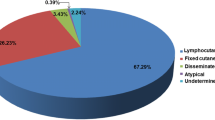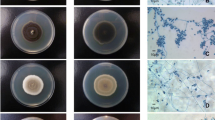Abstract
Purpose of Review
Sporotrichosis, the disease caused by Sporothrix spp, ranges from subcutaneous infections to the severe disseminated or invasive diseases. The taxonomy of Sporothrix has been revised. The subcutaneous disease is suspected easily, but the extra-cutaneous disease is diagnosed by chance or with high suspicion. This review provides the overview of currently available diagnostic techniques.
Recent Finding
Enzyme-linked immunosorbent assay (ELISA) or latex agglutination test with partially purified antigens helps in the diagnosis of extra-cutaneous sporotrichosis. Molecular methods have been used for the identification and typing of the fungus. Calmodulin, beta tubulin, translation elongation factor and chitin synthase genes are targeted for species differentiation. MALDI-TOF MS has been standardized to identify the species.
Summary
PCR-based molecular techniques and matrix-assisted laser desorption ionisation time of flight mass spectroscopy (MALDI-TOF MS) help in the identification of Sporothrix species, whereas ELISA helps in diagnosing extra-cutaneous form. Utility of molecular techniques for detection of Sporothrix directly from clinical specimen needs to be evaluated.
Similar content being viewed by others
References
Papers of particular interest, published recently, have been highlighted as: • Of importance•• Of major importance
• Chakrabarti A, Bonifaz A, Gutierrez-Galhardo MC, Mochizuki T, Li S. Global epidemiology of sporotrichosis. Med Mycol. 2015;53:3–14. A comperhensive review on the global epidemiology of sporotrichosis.
Aung AK, Teh BM, McGrath C, Thompson PJ. Pulmonary sporotrichosis: case series and systematic analysis of literature on clinico-radiological patterns and management outcomes. Med Mycol. 2013;51:534–44.
Barros MB, de Almeida PR, Schubach AO. Sporothrix schenckii and sporotrichosis. Clin Microbiol Rev. 2011;24:633–54.
Gold JA, Derado G, Mody RK, Benedict K. Sporotrichosis-associated hospitalizations, United States, 2000–2013. Emerg Infect Dis. 2016;22:1817–20.
• Marimon R, Cano J, Gene J, Sutton DA, Kawasaki M, Guarro J. Sporothrix brasiliensis, S. globosa, and S. mexicana, three new Sporothrix species of clinical interest. J Clin Microbiol. 2007;45(10):3198–206. First description of three pathogenic new species characterized on the basis of phenotypic and molecular techniques.
• de Beer ZW, Duong TA, Wingfield MJ. The divorce of Sporothrix and Ophiostoma: solution to a problematic relationship. Stud Mycol. 2016;83:165–91. A detailed taxonomy study and description of six species complexes in the genus.
Zhang Y, Hagen F, Stielow B, Rodrigues AM, Samerpitak K, Zhou X, et al. Phylogeography and evolutionary patterns in Sporothrix spanning more than 14 000 human and animal case reports. Persoonia. 2015;35:1–20.
Larone DH. Medically important fungi. 4th ed. Washington, D.C.: ASM Press; 2002. xviii, 409 p. p.
Gezuele E, Da Rosa D. Importance of the sporotrichosis asteroid body for the rapid diagnosis of sporotrichosis. Rev Iberoam Micol. 2005;22(3):147–50.
• Quintella LP, Passos SR, do Vale AC, Galhardo MC, Barros MB, Cuzzi T, et al. Histopathology of cutaneous sporotrichosis in Rio de Janeiro: a series of 119 consecutive cases. J Cutan Pathol. 2011;38:25–32. Histopathological description of large series of sporotrichosis.
Bullpitt P, Weedon D. Sporotrichosis: a review of 39 cases. Pathology. 1978;10:249–56.
Itoh M, Okamoto S, Kariya H. Survey of 200 cases of sporotrichosis. Dermatologica. 1986;172:209–13.
Espinosa-Texis A, Hernandez-Hernandez F, Lavalle P, Barba-Rubio J, Lopez-Martinez R. Study of 50 patients with sporotrichosis. Clinical and laboratory assessment. Gac Med Mex. 2001;137:111–6.
• Suzuki R, Yikelamu A, Tanaka R, Igawa K, Yokozeki H, Yaguchi T. Studies in phylogeny, development of rapid identification methods, antifungal susceptibility, and growth rates of clinical strains of Sporothrix schenckii complex in Japan. Med Mycol J. 2016;57:E47–57. Phenotpic, molecular characterization and antifungal susceptibility pattern of large collection of Sporothrix globosa from Japan.
• Antonio LF, Pimentel MI, Lyra MR, Madeira MF, Miranda LF, Paes RA, et al. Sporothrix schenckii sensu lato identification in fragments of skin lesion cultured in NNN medium for differential diagnosis of cutaneous leishmaniasis. Diagn Microbiol Infect Dis. 2017;87:118–20. Sporothrix can grow in NNN media hence any mould growth in this media should be identified.
•• Bernardes-Engemann AR, de Lima BM, Zeitune T, Russi DC, Orofino-Costa R, Lopes-Bezerra LM. Validation of a serodiagnostic test for sporotrichosis: a follow-up study of patients related to the Rio de Janeiro zoonotic outbreak. Med Mycol. 2015;53:28–33. Evaluated and validated the ELISA test as a new diagnostic tool applicable to all clinical presentation of sporotrichosis
de Albornoz MB, Villanueva E, de Torres ED. Application of immunoprecipitation techniques to the diagnosis of cutaneous and extracutaneous forms of sporotrichosis. Mycopathologia. 1984;85:177–83.
Blumer SO, Kaufman L, Kaplan W, McLaughlin DW, Kraft DE. Comparative evaluation of five serological methods for the diagnosis of sporotrichosis. Appl Microbiol. 1973;26:4–8.
Almeida-Paes R, Pimenta MA, Pizzini CV, Monteiro PC, Peralta JM, Nosanchuk JD, et al. Use of mycelial-phase Sporothrix schenckii exoantigens in an enzyme-linked immunosorbent assay for diagnosis of sporotrichosis by antibody detection. Clin Vaccine Immunol. 2007;14:244–9.
Bernardes-Engemann AR, Costa RC, Miguens BR, Penha CV, Neves E, Pereira BA, et al. Development of an enzyme-linked immunosorbent assay for the serodiagnosis of several clinical forms of sporotrichosis. Med Mycol. 2005;43:487–93.
• Alvarado P, Ostos A, Franquiz N, Roschman-Gonzalez A, Zambrano EA, Mendoza M. Serological diagnosis of sporotrichosis using an antigen of Sporothrix schenckii sensu stricto mycelium. Investig Clin. 2015;56:111–22. Evaluated antigen from Sporothrix schenkii sensu stricto and showed that it was highly specific and can be used for immunodiffusion tests as well as ELISA.
Scott EN, Kaufman L, Brown AC, Muchmore HG. Serologic studies in the diagnosis and management of meningitis due to Sporothrix schenckii. N Engl J Med. 1987;317:935–40.
Galhardo MC, Silva MT, Lima MA, Nunes EP, Schettini LE, de Freitas RF, et al. Sporothrix schenckii meningitis in AIDS during immune reconstitution syndrome. J Neurol Neurosurg Psychiatry. 2010;81:696–9.
Scott EN, Muchmore HG. Immunoblot analysis of antibody responses to Sporothrix schenckii. J Clin Microbiol. 1989;27:300–4.
• Hessler C, Kauffman CA, Chow FC. The upside of bias: a case of chronic meningitis due to Sporothrix schenckii in an immunocompetent host. Neurohospitalist. 2017;7:30–4. A good description on the importance of testing the CSF and serum in patients with chronic menengitis.
Oliveira MM, Almeida-Paes R, Gutierrez-Galhardo MC, Zancope-Oliveira RM. Molecular identification of the Sporothrix schenckii complex. Rev Iberoam Micol. 2014;31:2–6.
Ghosh A, Chakrabarti A, Sharma VK, Singh K, Singh A. Sporotrichosis in Himachal Pradesh (north India). Trans R Soc Trop Med Hyg. 1999;93:41–5.
• Hu S, Chung WH, Hung SI, Ho HC, Wang ZW, Chen CH, et al. Detection of Sporothrix schenckii in clinical samples by a nested PCR assay. J Clin Microbiol. 2003;41:1414–8. Demonstrated the utility of the detection of the fungal DNA directly form the clinical specimen using PCR assay.
Xu TH, Lin JP, Gao XH, Wei H, Liao W, Chen HD. Identification of Sporothix schenckii of various mtDNA types by nested PCR assay. Med Mycol. 2010;48:161–5.
• Liu X, Zhang Z, Hou B, Wang D, Sun T, Li F, et al. Rapid identification of Sporothrix schenckii in biopsy tissue by PCR. J Eur Acad Dermatol Venereol. 2013;27:1491–7. Evaluated different primers with isolates and biopsy and showed primer S2-R2 can be used in different geographical areas and clinical types with high specificity ands sensitivity.
• Rodrigues AM, de Hoog GS, de Cassia PD, Brihante RS, Sidrim JJ, Gadelha MF, et al. Genetic diversity and antifungal susceptibility profiles in causative agents of sporotrichosis. BMC Infect Dis. 2014;14:219. Study highlights the importance of species identification as some species exhibit resistance to multiple anti-fungals.
Fernandez-Silva F, Capilla J, Mayayo E, Guarro J. Efficacy of posaconazole in murine experimental sporotrichosis. Antimicrob Agents Chemother. 2012;56:2273–7.
• Ishida K, de Castro RA, Borba Dos Santos LP, Quintella LP, Lopes-Bezerra LM, Rozental S. Amphotericin B, alone or followed by itraconazole therapy, is effective in the control of experimental disseminated sporotrichosis by Sporothrix brasiliensis. Med Mycol. 2015;53:34–41. A good invivo study of antifungal agents on S.brasiliensis.
•• Rodrigues AM, de Hoog GS, de Camargo ZP. Molecular diagnosis of pathogenic Sporothrix species. PLoS Negl Trop Dis. 2015;9:e0004190. Description of panel of novel markers based on calmodulin gene for the diagnosis of sporotrichosis and its evaluation i murine model of disseminated sporotrichosis.
• Rodrigues AM, Cruz Choappa R, Fernandes GF, de Hoog GS, de Camargo ZP. Sporothrix chilensis sp. nov. (Ascomycota: Ophiostomatales), a soil-borne agent of human sporotrichosis with mild-pathogenic potential to mammals. Fungal Biol. 2016;120:246–64. Description of new species of Sporothrix.
Marimon R, Gene J, Cano J, Trilles L, Dos Santos LM, Guarro J. Molecular phylogeny of Sporothrix schenckii. J Clin Microbiol. 2006;44:3251–6.
O'Donnell K, NH, Aoki T, Cigelnik E. A multigene phylogeny of the Gibberella fujikuroi species complex: detection of additional phylogenetically distinct species. Mycoscience. 2000;41:61–78.
• Rodrigues AM, Najafzadeh MJ, de Hoog GS, de Camargo ZP. Rapid identification of emerging human-pathogenic Sporothrix species with rolling circle amplification. Front Microbiol. 2015;6:1385. A study in which highly specific and sensitive probes have been developed for the species specific identifiation of human pathogenic Sporothrix.
Mesa-Arango AC, Del Rocio R-MM, Perez-Mejia A, Navarro-Barranco H, Souza V, Zuniga G, et al. Phenotyping and genotyping of Sporothrix schenckii isolates according to geographic origin and clinical form of sporotrichosis. J Clin Microbiol. 2002;40:3004–11.
Neyra E, Fonteyne PA, Swinne D, Fauche F, Bustamante B, Nolard N. Epidemiology of human sporotrichosis investigated by amplified fragment length polymorphism. J Clin Microbiol. 2005;43:1348–52.
Watanabe S, Kawasaki M, Mochizuki T, Ishizaki H. RFLP analysis of the internal transcribed spacer regions of Sporothrix schenckii. Nihon Ishinkin Gakkai Zasshi. 2004;45:165–75.
Rodrigues AM, de Hoog GS, de Camargo ZP. Genotyping species of the Sporothrix schenckii complex by PCR-RFLP of calmodulin. Diagn Microbiol Infect Dis. 2014;78:383–7.
Galhardo MC, De Oliveira RM, Valle AC, Paes Rde A, Silvatavares PM, Monzon A, et al. Molecular epidemiology and antifungal susceptibility patterns of Sporothrix schenckii isolates from a cat-transmitted epidemic of sporotrichosis in Rio de Janeiro. Brazil Med Mycol. 2008;46:141–51.
de Oliveira MM, Sampaio P, Almeida-Paes R, Pais C, Gutierrez-Galhardo MC, Zancope-Oliveira RM. Rapid identification of Sporothrix species by T3B fingerprinting. J Clin Microbiol. 2012;50:2159–62.
• Rodriguez-Brito S, Camacho E, Mendoza M, Nino-Vega GA. Differential identification of Sporothrix species. and Leishmania spp. by conventional PCR and qPCR in multiplex format. Med Mycol. 2015;53:22–7. Developed multiplex PCR to detect and differentiate Leishmania and Sporothrix.
• Oliveira MM, Santos C, Sampaio P, Romeo O, Almeida-Paes R, Pais C, et al. Development and optimization of a new MALDI-TOF protocol for identification of the Sporothrix species complex. Res Microbiol. 2015;166:102–10. Developed and validated the MALDI-TOF MS protocol and database for the dientification of clinical and environment Sporothrix.
• Borba-Santos LP, Rodrigues AM, Gagini TB, Fernandes GF, Castro R, de Camargo ZP, et al. Susceptibility of Sporothrix brasiliensis isolates to amphotericin B, azoles, and terbinafine. Med Mycol. 2015;53:178–88. A good study on the invitro activity of antifungals against S. brasiliensis
Gutierrez-Galhardo MC, Zancope-Oliveira RM, Monzon A, Rodriguez-Tudela JL, Cuenca-Estrella M. Antifungal susceptibility profile in vitro of Sporothrix schenckii in two growth phases and by two methods: microdilution and E-test. Mycoses. 2010;53:227–31.
Ottonelli Stopiglia CD, Magagnin CM, Castrillon MR, Mendes SD, Heidrich D, Valente P, et al. Antifungal susceptibilities and identification of species of the Sporothrix schenckii complex isolated in Brazil. Med Mycol. 2014;52:56–64.
Marimon R, Serena C, Gene J, Cano J, Guarro J. In vitro antifungal susceptibilities of five species of Sporothrix. Antimicrob Agents Chemother. 2008;52:732–4.
Oliveira DC, Lopes PG, Spader TB, Mahl CD, Tronco-Alves GR, Lara VM, et al. Antifungal susceptibilities of Sporothrix albicans, S. brasiliensis, and S. luriei of the S. schenckii complex identified in Brazil. J Clin Microbiol. 2011;49:3047–9.
Author information
Authors and Affiliations
Corresponding author
Ethics declarations
Conflict of Interest
The authors declare that they have no competing interests.
Human and Animal Rights and Informed Consent
This article does not contain any studies with human or animal subjects performed by any of the authors.
Additional information
This article is part of the Topical Collection on Advances in Diagnosis of Invasive Fungal Infections
Rights and permissions
About this article
Cite this article
Rudramurthy, S.M., Chakrabarti, A. Sporotrichosis: Update on Diagnostic Techniques. Curr Fungal Infect Rep 11, 134–140 (2017). https://doi.org/10.1007/s12281-017-0283-8
Published:
Issue Date:
DOI: https://doi.org/10.1007/s12281-017-0283-8




